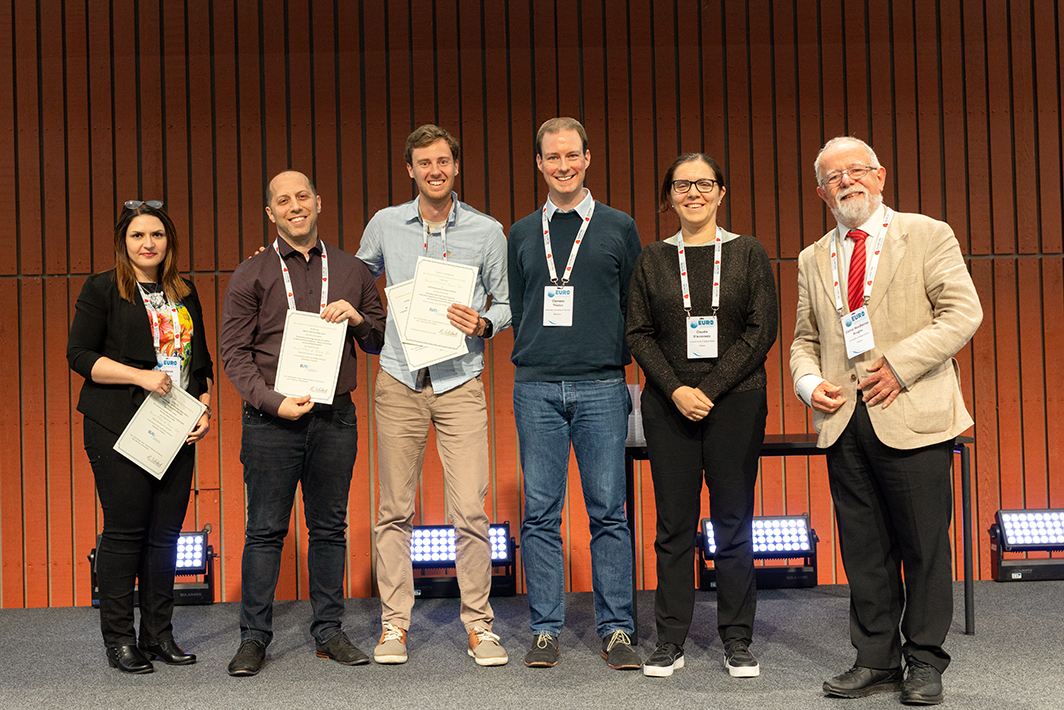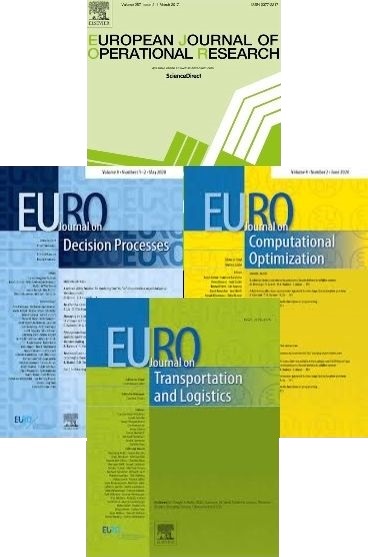EURO Prize for OR for the Common Good 2024 - Finalists

The three finalists of the 2022 EURO Prize for OR for the Common Good are:
Jan Boeckmann - Institute for Business Analytics and Technology Transformation, Johannes-Kepler University Linz
Clemens Thielen - TUM Campus Straubing for Biotechnology and Sustainability, Technical University of Munich
Rethinking Municipal Flood Mitigation: A Real-World Application of Operations Research Methods for Improving Climate Resilience
Adapting to the consequences of climate change is undeniably one of the paramount challenges of our time. Among these consequences, intense heavy rain events pose a significant threat by endangering human lives and causing severe damage to infrastructure through flash floods. Recent events such as the heavy rainfall and flooding in Western Europe in 2021, Pakistan 2022, and Libya 2023, have once more corroborated the enormous potential for damage and underscore the importance of developing high-quality mitigation concepts in order to reduce the impact of these events on communities and their infrastructure. Such mitigation concepts, however, are typically elaborated solely based on simulations resulting in a time-consuming trial-and-error approach that provides no quality guarantee for the obtained solutions.
In this talk, an approach that combines mixed-integer programming and a combinatorial graph algorithm for the automatic computation of high-quality flood mitigation concepts consisting of retention basins, embankments, and ditches is presented. This, to the best of our knowledge, is the first automated decision support approach for this critical application that scales well enough to be applied to realistic scenarios. Apart from the developed optimization algorithms, the talk also presents a comprehensive web-application that has been designed to make the algorithms available to a broad variety of users beyond the OR community. The work has been conducted within the project “Incentive Systems for Municipal Flood Mitigation” in an interdisciplinary team consisting of two academic research groups, an engineering office, two municipalities, and a municipal water association. By now, the resulting software has been used in practice by over 30 institutions from all over Germany reaching from local authorities over engineering offices to academic research groups. The empowerment of users with limited technical knowledge to design high-quality precautionary measures for pluvial flash floods sets the developed software apart from state-of-the-art approaches and marks a significant innovation showcasing the OR community’s contribution to societally vital topics.
Ohad Eisenhandler - Afeka College of Engineering, Tel Aviv, Israel
Gur Mittelman - Afeka College of Engineering, Tel Aviv, Israel
Moshe Tshuva - Afeka College of Engineering, Tel Aviv, Israel
Ronen Eran - Afeka College of Engineering, Tel Aviv, Israel
Lev Zhivin - Afeka College of Engineering, Tel Aviv, Israel
Yossi Luzon - Afeka College of Engineering, Tel Aviv, Israel
The potential of renewable electricity in isolated grids: The case of Israel in 2050.
The global urgency to mitigate climate change and reduce greenhouse gas emissions has intensified efforts to transition towards renewable energy sources. Isolated electrical grids, characterized by their detachment from larger networked systems, present unique challenges in this transition. This study, focusing on Israel’s grid as a model for the year 2050, aims to address these challenges by employing a holistic approach that integrates advanced modeling techniques to assess the potential of renewable energy integration effectively. Employing a comprehensive methodology, this research incorporates a detailed Performance Model (PM) and an Energy Management System (EMS) model. The PM evaluates the hourly electrical output from diverse renewable sources, including solar (photovoltaics and agrivoltaics), onshore and offshore wind, sea waves, and organic waste, taking into account Israel's specific geographic and climatic conditions. The EMS model then optimizes the alignment between this renewable energy supply, the anticipated demand, and necessary storage solutions. This approach includes extensive data collection on renewable energy potentials, area mapping for solar installations, and evaluations of wind and sea wave energy potentials based on geographical and meteorological data. The innovative aspect of considering organic waste adds an additional layer of resource diversification. The findings reveal a significant potential for Israel to increase its renewable energy share to between 80.1% and 99.5% by the year 2050, contingent upon the implementation scenario. Achieving such a high level of renewable integration hinges on developing substantial energy storage capacities. This research identifies a feasible combination of the Vehicle to Grid (V2G) concept, stationary batteries, and pumped hydroelectric plants as viable solutions for meeting the projected total electric demand of 183.3 TWh in 2050, with renewable resources providing an installed capacity of 180.6 GW. A key outcome of the study is the emphasis on agrivoltaics and the V2G concept as instrumental in enhancing the grid's renewable capacity. These innovations not only conserve land resources but also offer the requisite storage to manage the inherent variability of renewable energy sources. Moreover, the study underscores the importance of adopting a comprehensive energy management approach capable of accommodating the dynamic nature of renewable energy production and consumption. This research contributes to the broader discourse on renewable energy potentials in isolated grids, providing critical insights for policymakers, energy planners, and researchers. It underscores the feasibility and necessity of employing advanced modeling techniques to evaluate and optimize the integration of renewable energy sources, highlighting the need for significant storage capacities and innovative solutions like agrivoltaics and V2G. The implications of this study for energy policy and planning are profound, especially for regions with isolated grids similar to Israel. It encourages policymakers and energy planners to consider the methodologies and findings presented to make informed decisions regarding renewable energy investments and infrastructure development. Furthermore, the research highlights the pivotal role of innovation in energy storage and management technologies in maximizing the potential of renewable energy sources. In conclusion, the integration of renewable energy into isolated grids, exemplified by the case study of Israel in 2050, is both a viable and essential strategy for moving towards a sustainable energy future. This study lays the groundwork for future research to explore emerging technologies and storage solutions, ensuring that renewable energy can adequately meet growing demands while addressing environmental concerns.
Ashraf Labib - Strategy and Business Systems, University of Portsmouth
Dylan Jones - Mathematics, University of Portsmouth
Formulation of Strategy Towards the ARCTIC in terms of Search and Rescue – Needs, Innovations, and AI/OR based solutions
This seminar presents a usage of operational research methodologies during the ARCSAR (arcsar.eu) and AI-ARC EU-H2020 projects for enhancing safety and avoiding environmental damage in the Arctic and North Atlantic (ANA) maritime domain. The ARCSAR and AI-ARC (ai-arc.eu) projects arose due to concerns regarding the effects of increased maritime activity in the multi-national ANA region, caused by the melting ice due to climate change. The authors principal focus in the ARCSAR project has been working with search and rescue (SAR) and marine environmental response (MER) practitioners and other ANA stakeholders to classify and prioritise innovation needs. The overall aim is to lower the likelihood and social, environmental and economic consequences of large-scale incidents in ANA waters such as (i) a cruise ship sinking, (ii) a significant oil spill or (iii) a nuclear leakage. The AI-ARC project focused on developing and demonstrating an AI-based virtual control room that can improve decisions related to situational awareness, and assessment of risks against maritime incidents such as grounding, collision, oil spill, etc.
The seminar will first describe the holistic operational research process undertaken. This first involved a hierarchical classification of current and future ANA innovation needs, based at the highest level around the international maritime organisation (IMO)’s polar code. To achieve this, a series of workshops, questionnaires and interviews and literature review were used. These drew responses from 131 ANA stakeholders, including SAR and MER practitioners, environmentalists, NGO and charity representatives, indigenous peoples group representatives, industrialists and academics. This resulted in a hierarchical network of 20 need and 75 sub-need categories. A quantitative methodology using a combined PICK chart and Multi-Criteria Decision Making was then used to develop a priority set of 17 sub-needs. The PICK chart classified the needs according to importance and difficulty whilst a novel balanced knapsack goal programming model was developed to choose a high importance set of sub-needs, whilst considering the balance between long-term (more challenging) and shorter term (more implementable) innovation needs and across the six polar need categories.
The process of disseminating the methodology to ANA stakeholders and its usage to inform ARCSAR activities will be described. This involved a series of stakeholder workshops, where SWOT analyses around a set of the priority list innovations were undertaken. The priority needs were also used to inform significant activities, including a LiveEX ship evacuation exercise in Svalbard Norway. With respect to AI-ARC, the development of the risk index using AI based FL rule-based system and MCDM techniques to analyse data related to real-time AIS (ship conditions and position) combined with weather and human judgements will also be presented.
Finally, some highlights of the policy and practice impacts of the development of innovations to tackle the identified needs will be detailed. These include:
- The development of a set of training materials and procedures to use by ANA communities in the case of a nuclear incident
- An Arctic lessons learned arena for SAR and MER practitioners to share good practice
- Development of an AI-based virtual control room for safer ANA maritime navigation
- Enhanced training exercises and protocols for handling oil-on-ice in the case of an ANA oil spill
- Evidence given to, and cited by, a UK parliamentary enquiry on future Arctic policy
- Enhanced SAR operations in the Antarctic maritime region due to participation and knowledge transfer by Maritime New Zealand
Overall conclusions will then be drawn, including transferability of the developed methodology to other complex, multi-disciplinary situations where innovations to enhance safety and ensure wellbeing are needed.

This work is licensed under a Creative Commons Attribution-ShareAlike 3.0 International License and the GNU Free Documentation License (unversioned, with no invariant sections, front-cover texts, or back-cover texts).
